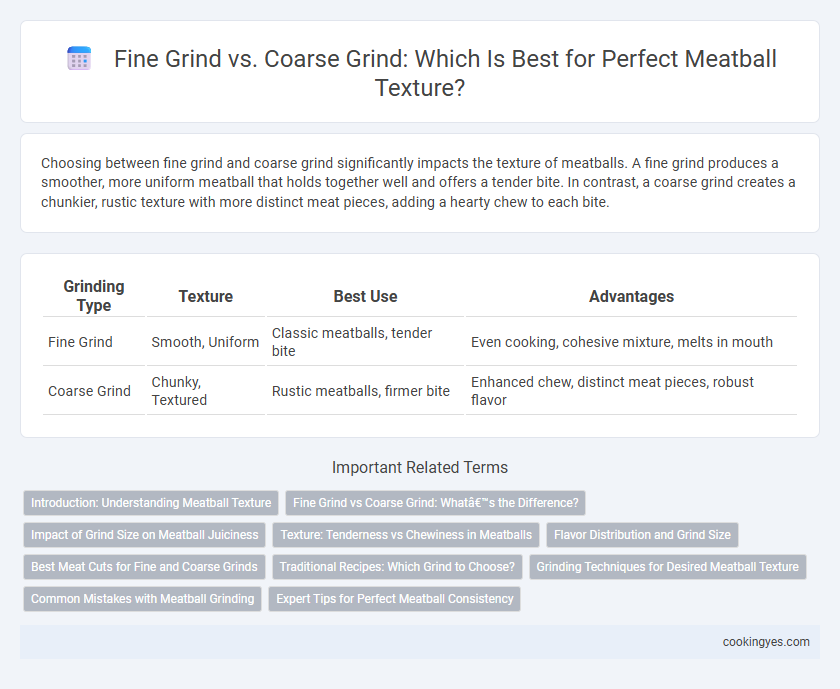Choosing between fine grind and coarse grind significantly impacts the texture of meatballs. A fine grind produces a smoother, more uniform meatball that holds together well and offers a tender bite. In contrast, a coarse grind creates a chunkier, rustic texture with more distinct meat pieces, adding a hearty chew to each bite.
Table of Comparison
| Grinding Type | Texture | Best Use | Advantages |
|---|---|---|---|
| Fine Grind | Smooth, Uniform | Classic meatballs, tender bite | Even cooking, cohesive mixture, melts in mouth |
| Coarse Grind | Chunky, Textured | Rustic meatballs, firmer bite | Enhanced chew, distinct meat pieces, robust flavor |
Introduction: Understanding Meatball Texture
Meatball texture is significantly influenced by the grind size of the meat used, with fine grind creating a tender, cohesive interior while coarse grind offers a chunkier, more rustic bite. Understanding the impact of fine versus coarse grind helps achieve the desired mouthfeel and structural integrity in meatballs, balancing moisture retention and firmness. Selecting the appropriate grind size plays a crucial role in the overall flavor release and cooking performance of meatballs.
Fine Grind vs Coarse Grind: What’s the Difference?
Fine grind meat creates a denser, smoother texture in meatballs, allowing for better binding and a more uniform cook, ideal for tender, cohesive results. Coarse grind offers a chunkier, more rustic texture with distinct meat pieces, producing a juicier bite and more pronounced flavor variations. Choosing between fine and coarse grind depends on desired mouthfeel and cooking technique, with fine grind suited for delicate blends and coarse grind for hearty, textured meatballs.
Impact of Grind Size on Meatball Juiciness
Fine grind meatballs retain moisture more effectively, resulting in a tender and juicy texture due to the increased surface area that allows better fat distribution. Coarse grind meatballs offer a firmer bite with a more pronounced meat texture, but they tend to lose moisture faster during cooking, which can reduce juiciness. Adjusting grind size directly influences the balance between moisture retention and texture, making fine grind preferable for juiciness and coarse grind better for a meatier bite.
Texture: Tenderness vs Chewiness in Meatballs
Fine grind meatballs create a tender texture by breaking down the meat fibers more thoroughly, allowing seasonings and fats to blend evenly for a melt-in-the-mouth experience. Coarse grind retains larger meat particles, enhancing chewiness and providing a hearty bite that highlights the meat's natural structure. Selecting between fine and coarse grind directly impacts the balance of tenderness and chewiness, tailoring meatball texture to personal preference or recipe style.
Flavor Distribution and Grind Size
Fine grind meatballs offer superior flavor distribution as the smaller meat particles absorb marinades and spices more thoroughly, creating a consistent taste throughout. Coarse grind meatballs provide a chunkier texture that enhances the overall mouthfeel but may result in uneven seasoning pockets. Choosing the grind size impacts both the flavor intensity and the texture experience, making fine grind ideal for smooth, cohesive bites and coarse grind better for rustic, hearty meatballs.
Best Meat Cuts for Fine and Coarse Grinds
Fine grind for meatballs works best with tender cuts like chuck roast or sirloin, which provide a smooth, cohesive texture ideal for delicate, melt-in-your-mouth meatballs. Coarse grind benefits from fattier cuts such as brisket or short rib, offering a heartier, juicier bite and more pronounced meat texture. Selecting the right grind and cut combination is essential for balancing moisture, flavor, and mouthfeel in homemade meatballs.
Traditional Recipes: Which Grind to Choose?
Traditional meatball recipes often call for a fine grind to create a tender, uniform texture that holds together well during cooking. Coarse grind provides a heartier bite and more pronounced meatiness, preferred in rustic or regional variations where a chewier mouthfeel is desired. Choosing between fine and coarse grind depends on whether a smooth, delicate texture or a robust, meaty consistency best suits the specific traditional meatball style.
Grinding Techniques for Desired Meatball Texture
Fine grind meat ensures a tender, cohesive meatball texture by breaking down muscle fibers to blend fat and lean meat thoroughly, while coarse grind provides a chunkier, hearty bite with more pronounced meat texture. Combining grinding techniques, such as double grinding or mixing fine and coarse grinds, allows for precise control over moisture retention and bite firmness. Proper grinding speed and cold equipment usage prevent fat smearing, preserving texture and juiciness in the final meatball.
Common Mistakes with Meatball Grinding
Using a fine grind for meatballs often results in a dense, mushy texture due to over-compression of the fat and meat, while a coarse grind provides a looser, more tender bite by preserving the meat's structure. A common mistake is grinding the meat too finely, which causes the meatballs to lose their juiciness and develop a rubbery texture after cooking. Ensuring the right grind size--typically medium to coarse--balances moisture retention and proper binding for the ideal meatball consistency.
Expert Tips for Perfect Meatball Consistency
Fine grind meat creates a dense, uniform texture ideal for tender meatballs that hold shape during cooking, while coarse grind offers a chunkier bite with enhanced juiciness and rustic appeal. Experts recommend combining both grinds to balance moisture retention and structural integrity, ensuring meatballs remain juicy without falling apart. Incorporating a small amount of fat and properly mixing with binders like breadcrumbs and eggs further refines consistency for perfect, flavorful results.
Fine Grind vs Coarse Grind for Meatball Texture Infographic

 cookingyes.com
cookingyes.com